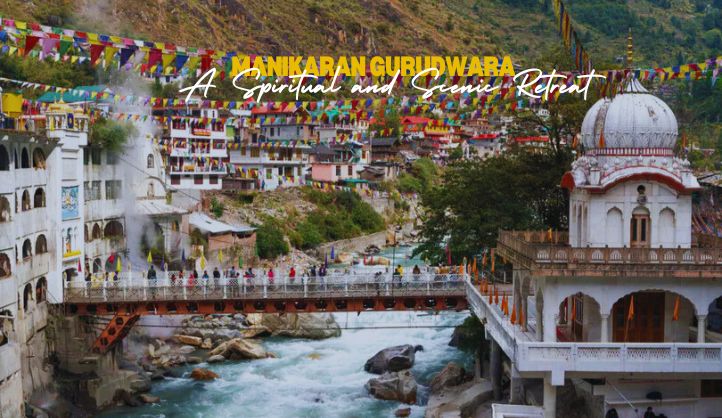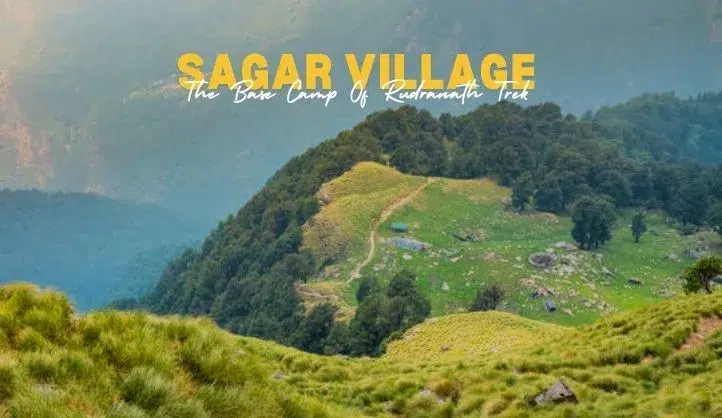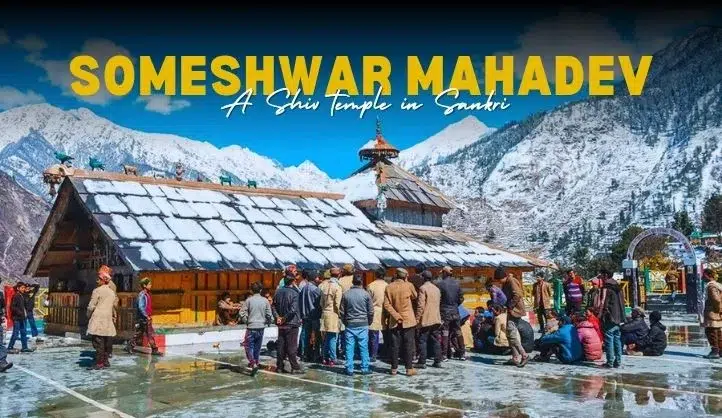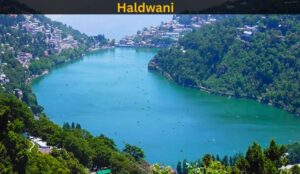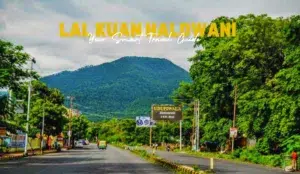Manikaran Gurudwara, also known as Sri Guru Nanak Dev Ji Gurudwara, is a revered pilgrimage site nestled in the breathtaking Parvati Valley of Himachal Pradesh. Renowned for its spiritual significance, natural beauty, and healing hot springs, Manikaran is a must-visit destination for both religious devotees and nature enthusiasts.
Location and Setting
Manikaran is situated in the Kullu district of Himachal Pradesh, approximately 45 kilometers from Kullu town and 4 kilometers from Kasol. Perched at an altitude of about 1,760 meters above sea level, this serene hamlet is surrounded by lush green hills, dense forests, and the gurgling Parvati River. The location’s pristine beauty enhances its appeal as a tranquil spiritual haven.
Historical Significance
The history of Manikaran Gurudwara is steeped in Sikh and Hindu mythology. The site is associated with two major legends:
a) Sikh Connection
According to Sikh traditions, Guru Nanak Dev Ji, the founder of Sikhism, visited Manikaran in the 16th century along with his disciple Bhai Mardana. It is believed that Guru Nanak performed miracles during their stay to help the locals. One of the most famous stories recounts how Guru Nanak asked Bhai Mardana to collect food for langar (community meal). However, there was no fire to cook the food. Guru Nanak instructed Mardana to lift a stone, revealing a hot spring that could cook the food. This miracle is commemorated by the hot springs of Manikaran.
b) Hindu Mythology
Manikaran is also significant in Hinduism. Legend has it that Lord Shiva and Goddess Parvati spent several years meditating here. During their stay, Parvati lost her earring (mani) in the river. When Shiva ordered his attendants to retrieve it, the serpent god Sheshnag spewed hot water, causing the lost jewel to emerge from the depths. This event is said to have created the hot springs of Manikaran.
Spiritual Importance
Manikaran Gurudwara holds immense spiritual value for Sikhs and Hindus alike. For Sikhs, it is a sacred site linked to Guru Nanak’s teachings and miracles. For Hindus, it is revered as a divine place blessed by Lord Shiva and Parvati.
The Gurudwara serves as a center for meditation, prayer, and selfless service (seva). Devotees believe that bathing in the hot springs and offering prayers at the Gurudwara purifies the soul and washes away sins.
Architectural Features
The architecture of Manikaran Gurudwara is a blend of simplicity and spiritual elegance. The white and yellow structure, adorned with a domed roof, stands as a symbol of purity and peace. The Gurudwara complex includes:
a) Main Prayer Hall (Darbar Sahib)
The Darbar Sahib is where devotees congregate for prayers and kirtans (devotional songs). The ambiance inside is serene, filled with the divine sounds of Gurbani.
b) Langar Hall
The langar hall is an integral part of the Gurudwara, offering free meals to all visitors, irrespective of religion or background. The food is prepared using the heat from the hot springs, symbolizing communal harmony and divine blessings.
c) Hot Springs
The natural hot springs are a key attraction. The water is believed to have medicinal properties, and many pilgrims bathe here to seek healing and spiritual rejuvenation.
d) Accommodation Facilities
The Gurudwara offers simple yet comfortable accommodations for pilgrims. These rooms are available on a first-come, first-served basis and reflect the ethos of hospitality and inclusivity.
Natural Wonders
The hot springs of Manikaran are a geological marvel. The temperature of the water ranges from 65°C to 80°C, making it ideal for cooking and bathing. The springs are rich in minerals, and their therapeutic properties attract visitors seeking relief from ailments such as arthritis, skin disorders, and respiratory issues.
The Parvati River, flowing adjacent to the Gurudwara, adds to the site’s natural charm. The river’s cold water juxtaposed with the steaming hot springs creates a fascinating spectacle.
Festivals and Celebrations
Manikaran Gurudwara is a hub of activity during Sikh and Hindu festivals. Key events include:
a) Baisakhi
Baisakhi, the Sikh New Year, is celebrated with great enthusiasm. Devotees gather to sing hymns, perform prayers, and partake in the langar.
b) Guru Nanak Jayanti
The birth anniversary of Guru Nanak Dev Ji is marked by kirtans, processions, and the recitation of Guru Granth Sahib, the holy scripture of Sikhism.
c) Shivratri
Hindus flock to Manikaran during Shivratri to worship Lord Shiva and take a dip in the holy springs.
Nearby Places to Explore Around Manikaran Gurudwara
Manikaran is not only a spiritual retreat but also a gateway to numerous picturesque and culturally rich destinations in the Parvati Valley. Here is a detailed look at some must-visit places near Manikaran Gurudwara:
1. Kasol
Known as the “Mini Israel of India,” Kasol is a serene village nestled along the banks of the Parvati River. It is a hub for backpackers and nature enthusiasts, offering a blend of scenic beauty and vibrant cultural experiences.
Key Highlights:
- River Walks: Stroll along the Parvati River and enjoy the calming sound of gurgling water.
- Café Culture: Savor Israeli and continental cuisines at the local cafés, such as Evergreen Café and Moon Dance Café.
- Shopping: Explore the flea market for unique handicrafts, woolens, and jewelry.
- Trekking Base: Kasol serves as the starting point for treks to Kheer Ganga, Tosh, and Malana.
2. Tosh Village
Perched at an altitude of 2,400 meters, Tosh is a charming village that offers panoramic views of snow-capped mountains and verdant valleys.
Key Highlights:
- Tosh Waterfall: A short hike leads to a stunning waterfall surrounded by lush greenery.
- Scenic Trekking Routes: The village is a gateway to the Tosh Glacier and offers excellent trails for adventure seekers.
- Traditional Culture: Experience the simplicity of Himachali village life and interact with friendly locals.
3. Kheer Ganga
Kheer Ganga is a popular trekking destination known for its mystical aura, scenic beauty, and therapeutic hot springs. The trek begins at Barshaini, which is 16 km from Manikaran.
Key Highlights:
- Hot Water Springs: Relax in the natural hot springs at the top, believed to have healing properties.
- Stunning Views: Enjoy breathtaking vistas of the Parvati Valley during the trek.
- Shiva Temple: Visit the ancient temple dedicated to Lord Shiva, adding a spiritual touch to your journey.
4. Chalal
Chalal is a quaint village that exudes rustic charm and offers a peaceful escape from the bustling tourist spots.
Key Highlights:
- Trek Along the River: The short trek from Kasol to Chalal takes you through pine forests and alongside the Parvati River.
- Art and Music: Known for hosting music festivals and art gatherings, Chalal is a haven for artists and creatives.
- Camping: Spend the night under the stars in one of the camping sites near the village.
5. Malana
Malana is a mystical village renowned for its distinct culture, language, and legal system. It is often referred to as the “Village of Taboos.”
Key Highlights:
- Unique Culture: Explore the village’s self-governed system and ancient customs.
- Malana Cream: The village is famous for producing high-quality cannabis known as Malana Cream.
- Jamlu Devta Temple: A sacred temple dedicated to Jamlu Devta, the presiding deity of Malana.
6. Pulga and Kalga Villages
Pulga and Kalga are twin villages located near Barshaini and are ideal for travelers seeking solitude and natural beauty.
Key Highlights:
- Apple Orchards: Walk through lush apple orchards and enjoy the fresh mountain air.
- Fairy Forest: Pulga is home to a mystical forest filled with tall deodar trees and serene trails.
- Eco-Stay Experiences: Stay in rustic wooden cottages and guesthouses offering cozy accommodations.
7. Bhuntar
Bhuntar serves as the gateway to the Parvati Valley and is known for its serene landscapes and religious significance.
Key Highlights:
- Bijli Mahadev Temple: A revered temple atop a hill, offering panoramic views of the Kullu Valley.
- Confluence of Beas and Parvati Rivers: Witness the merging of two rivers at Bhuntar, creating a tranquil environment.
8. Naggar
Naggar is a historical town near Kullu that offers a mix of culture, history, and stunning landscapes.
Key Highlights:
- Naggar Castle: Explore this ancient castle turned heritage hotel, known for its blend of European and Himalayan architecture.
- Roerich Art Gallery: Visit the art gallery dedicated to the works of Russian painter Nicholas Roerich.
- Temples: Discover the unique wooden temples of Gauri Shankar and Tripura Sundari.
9. Barshaini
Barshaini is a small village that serves as a base for treks to Kheer Ganga, Tosh, and other destinations in the Parvati Valley.
Key Highlights:
- Stunning Views: Enjoy picturesque views of the Parvati River and surrounding peaks.
- Trekking Hub: Begin your adventure to nearby destinations like Pulga, Kalga, and Rudra Nag Waterfall.
10. Manali
While a bit farther away, Manali is one of Himachal Pradesh’s most popular tourist destinations and offers a range of activities and attractions.
Key Highlights:
- Solang Valley: Experience adventure sports like paragliding, zorbing, and skiing.
- Old Manali: Explore quaint cafés, vibrant markets, and cultural sites in Old Manali.
- Hidimba Devi Temple: Visit this unique temple surrounded by cedar forests.
Travel Tips for Exploring Nearby Places
- Weather Preparedness: Carry warm clothing, especially if visiting during winter.
- Fitness Level: Some treks require moderate to good physical fitness; plan accordingly.
- Local Customs: Respect the culture and traditions of the villages you visit.
- Stay Options: Book accommodations in advance during peak tourist seasons.
Exploring these nearby places adds depth to your visit to Manikaran, offering a mix of spiritual, natural, and cultural experiences. Each destination enhances the charm of your journey through the enchanting Parvati Valley.
How to Reach Manikaran Gurudwara
a) By Road
Manikaran is well-connected by road. Regular buses and taxis operate from Kullu, Manali, and Bhuntar.
b) By Air
The nearest airport is Bhuntar Airport, located about 35 kilometers from Manikaran. From there, taxis and buses are readily available.
c) By Train
The nearest railway station is Joginder Nagar, approximately 145 kilometers away. Visitors can take buses or hire taxis to reach Manikaran.
Travel Tips
- Clothing: Carry warm clothing as temperatures can drop significantly, especially at night.
- Footwear: Comfortable footwear is essential for exploring the Gurudwara and nearby attractions.
- Health Precautions: Consult a doctor before bathing in the hot springs if you have any medical conditions.
- Photography: Respect the sanctity of the site and follow guidelines for photography.
Conclusion
Manikaran Gurudwara is not just a place of worship but a harmonious blend of spirituality, natural beauty, and cultural richness. Its serene atmosphere, coupled with the awe-inspiring Parvati Valley and the miraculous hot springs, makes it a unique destination for pilgrims and travelers alike. Whether you seek divine blessings, solace in nature, or a glimpse into the rich cultural heritage of India, Manikaran Gurudwara offers an experience that is both profound and unforgettable.
FAQs About Manikaran Gurudwara
1. What is the significance of Manikaran Gurudwara?
Manikaran Gurudwara, also known as Sri Guru Nanak Dev Ji Gurudwara, is a revered Sikh pilgrimage site located in Himachal Pradesh. It is believed that Guru Nanak Dev Ji visited this place during the third Udasi (journey) and performed miracles. The site is known for its hot springs, which hold spiritual and medicinal significance.
2. Are there hot springs at Manikaran Gurudwara?
Yes, Manikaran is famous for its natural hot springs, which are believed to have healing properties. Visitors often take a dip in these waters as it is considered spiritually purifying. The hot springs are also used to cook food served in the Gurudwara’s langar.
3. How can I reach Manikaran Gurudwara?
- By Road: Manikaran is well-connected by road and can be reached via Kasol or Bhuntar. Local buses and taxis are available from nearby towns.
- By Air: The nearest airport is Kullu-Manali Airport in Bhuntar, approximately 35 km away.
- By Train: The closest railway station is Joginder Nagar, located about 145 km from Manikaran.
- By Trek: Adventure enthusiasts can trek from nearby villages like Tosh or Barshaini.
4. Is there any accommodation available at Manikaran Gurudwara?
Yes, the Gurudwara offers basic accommodation for pilgrims and visitors. These facilities are simple yet comfortable, emphasizing humility and service. Alternatively, you can find hotels and guesthouses in nearby Kasol or other villages in the Parvati Valley.
5. What are the darshan timings at Manikaran Gurudwara?
The Gurudwara is open from early morning (around 4:00 AM) to late evening (around 10:00 PM). Regular prayers, kirtan, and langar services are held throughout the day. Visitors are welcome at any time during these hours.
6. Are there any dress codes or rules to follow at the Gurudwara?
Yes, visitors are expected to follow certain guidelines:
- Cover your head with a scarf or handkerchief.
- Remove shoes before entering the premises.
- Maintain silence and avoid causing any disturbances.
- Dress modestly and refrain from bringing alcohol, tobacco, or non-vegetarian food.
7. Can non-Sikhs visit Manikaran Gurudwara?
Yes, people of all religions and backgrounds are welcome to visit the Gurudwara. Sikhism promotes the concept of universal brotherhood, and the Gurudwara is open to anyone seeking spiritual solace or cultural understanding.
8. Is there a langar (community kitchen) service available?
Yes, the Gurudwara runs a langar that serves free meals to all visitors, irrespective of their religion or background. The food is cooked in the natural hot springs and is considered a blessing. Visitors can also participate in the seva (selfless service) by volunteering in the kitchen or other activities.

